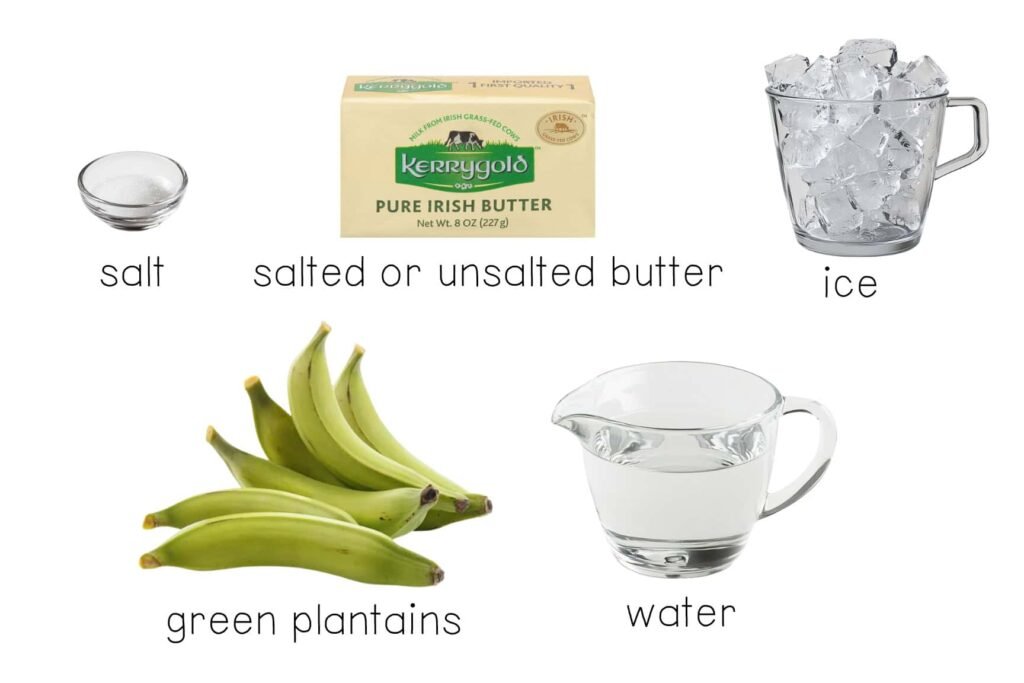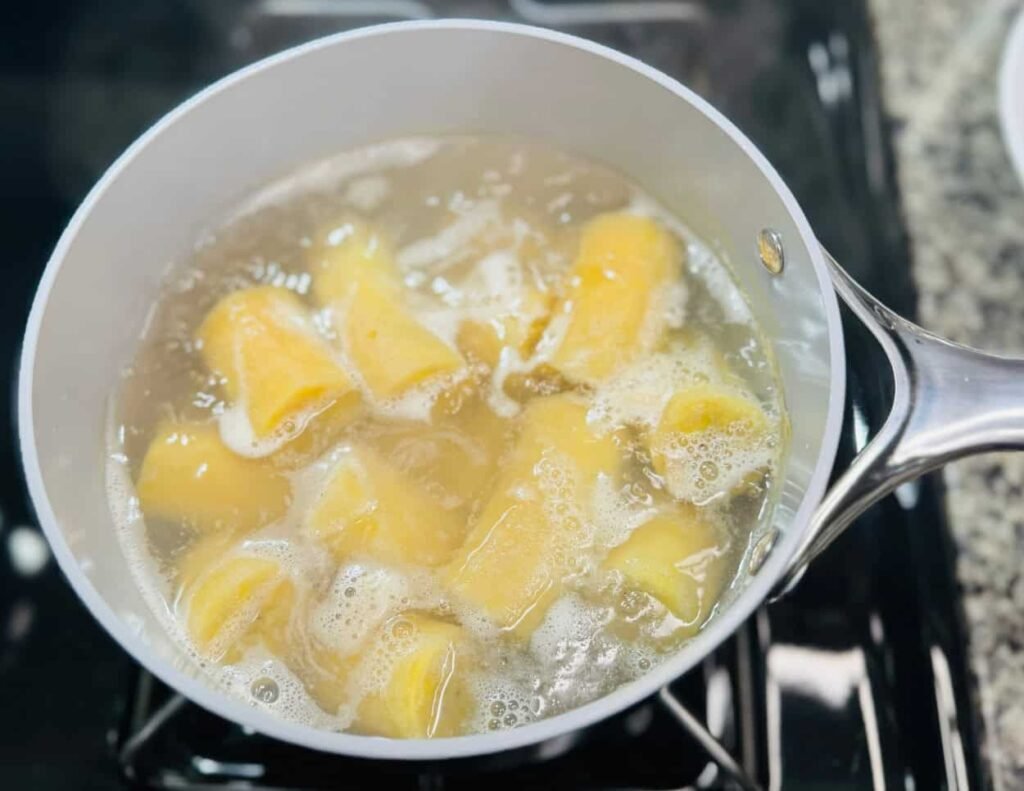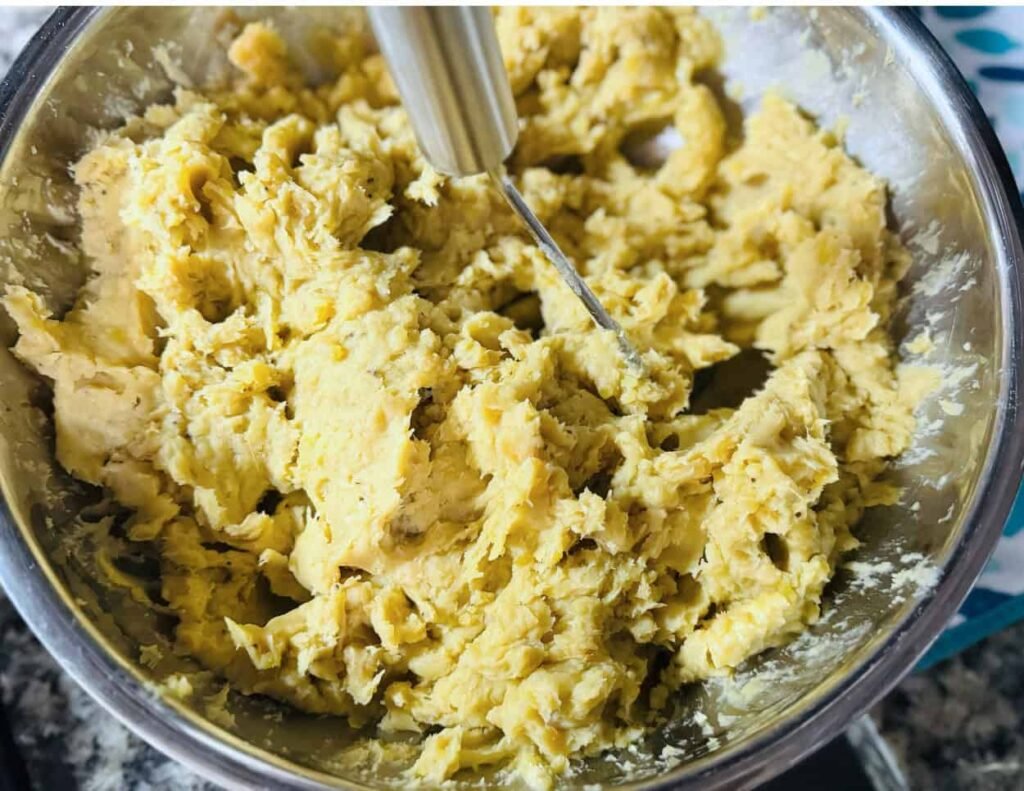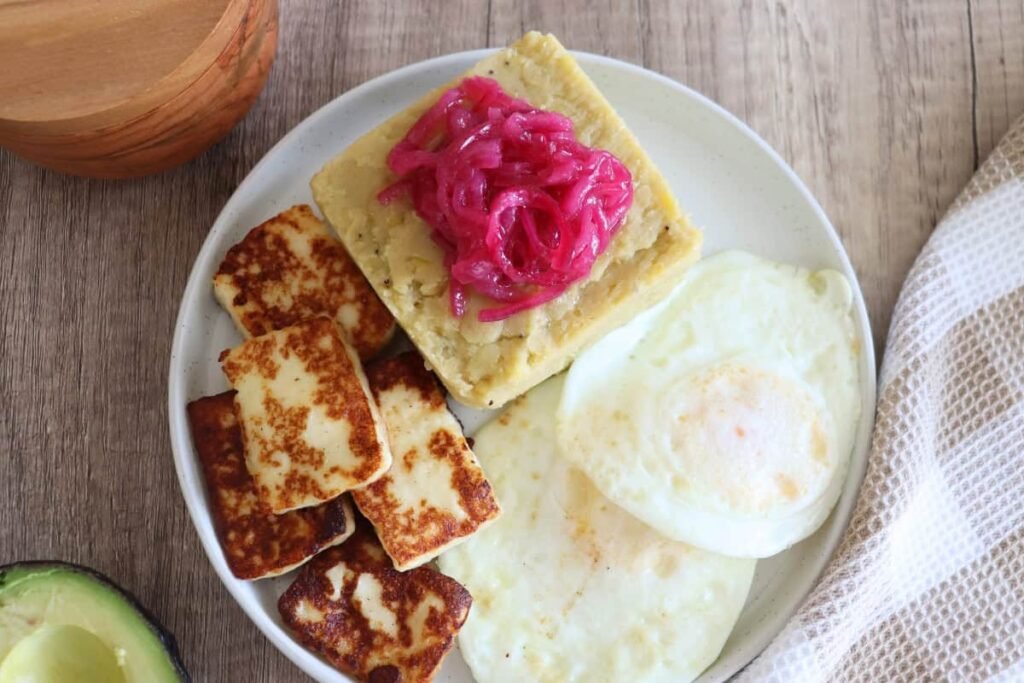Mangú is rich in complex carbohydrates and dietary fiber. It is also a good source of vitamins A and C, magnesium, and potassium. Mangú provides energy and aids digestion. If made using a plant-based butter alternative, it can be vegan.
Mangu

Say hello to the most iconic Dominican breakfast: Mangú! This smooth and savory mashed plantain dish comes together with just five ingredients and a few simple steps. It’s buttery, perfectly salted, and so delicious! If I could only eat one breakfast for the rest of my life, it would be Mangú.
In my opinion, Mangú should be served warm with fried cheese, eggs, avocado, and sautéed pickled onions—it’s a meal that’s satisfying, comforting, and impossible to resist.
Mangú is deeply rooted in Dominican culture, representing a rich blend of African and indigenous Taíno culinary traditions. It’s the kind of dish that’s perfect any time of day—morning, noon, or night. Now, let’s learn how to make this hearty and delicious breakfast!
Inside This Post
What You'll Love About This Mangú Recipe
Mangú is a simple dish that is easy to make, and I don’t think I will ever get tired of eatin
These are my top reasons for loving this recipe, and I think you will, too:
- Mild Flavor: great for toddlers and children who do not like bold flavors.
- Beginner Friendly: easy to make (peel, boil, mash, and season with salt and butter).
- Requires few ingredients: only 5 ingredients needed, including water and ice.
- Suitable for Any Meal: breakfast, lunch, or dinner, mangú is the perfect meal.
- Pairs with Multiple Proteins: eggs, cheese, salami, chicken, beef, to name a few.
What You Will Need To Make Mangú

To make mangú, here’s everything you’ll need on hand:
- Green plantains: the greener the better. If you get them yellow, the mangú will be sweet.
- Butter: gives richness and a creamy texture. I use Kerrygold butter. It reminds me of the butter sold in the Dominican Republic.
- Salt: enhances flavor, make sure the water is properly salted. Add more salt if needed when mashing the plantains. Remember that if you use salted butter, you should use less salt. (A helpful rule of thumb for salting water when boiling plantains is to use 1 teaspoon of salt for every cup of water.)
- Water: (boiling and mashing plantains) you will need enough water to cover the plantains as they cook
- Ice-cubes: are the secret to smooth Mangu, which will not be hard even after refrigerated.
- Optional: pickled onions, cheese, salami, eggs, and longaniza (Dominican sausage).
Step-By-Step Instructions
1. Boil Water
Put a large pot of water on the stove and set it to medium-high heat. Bring it to a boil.
2. Peel Plantains
Peel the green plantains, slicing each into 2–3 chunks. If you’re starting with cold plantains, give them about 30 minutes at room temperature first—this simple trick makes the peeling process much smoother.
Time-Saving Tip: After cutting the plantains into chunks, slice each piece lengthwise. This speeds up cooking and ensures the plantains soften evenly in the water.
3. Boil Plantains
Once the water is boiling, add the plantains and salt. I like to add ½ tablespoon of vinegar or lime juice to the water as well. It helps keep the plantains’ color bright. Reduce heat to medium-low and cook for 20–25 minutes, or until fork-tender. Keep the plantains fully covered in water. Add more water if needed.
4. Drain the Plantains
After 20-25 minutes, check if the plantains are fully cooked by inserting a fork. If the fork inside goes inside, the plantains are ready. Drain the plantains and transfer them to a bowl.
5. Mash Plantains
Add butter and mash using a potato masher or fork. Gradually add the cold water and ice cubes until you reach your desired consistency. Taste for salt. Enjoy the mangú warm and serve alongside your favorite protein.
How Your Kids Can Help
My boys love helping me in the kitchen. Some ways your child can help you make this dish include the following:
- Gather the Ingredients: children can take out the plantains from the fridge. Tell them the number of plantains you’ll need and have them place them at a designated spot. This task helps kids practice number sense and following directions.
- Little Sous Chef: they can assist you in measuring water, oil, salt, and butter (an excellent way to practice basic math and measuring skills).
- Cooking Time Keeper: Set a timer and have your child track the 20-25 minutes it takes for the plantains to cook (helps develop time awareness and responsibility).
- Taste Tester: Have your child rate the recipe from 1-10. Ask questions about the recipe (what would you change about the recipe, what is their favorite pairing option) etc. This dialogue helps children practice their critical thinking and conversational skills.
Frequently Asked Questions
What kind of plantains should I use for mangú?
Always go for green plantains—the greener, the better! They should feel firm to the touch. Yellow or ripened plantains are sweeter and will not give you that savory flavor that Mangú is known for. My go-to brand for plantains is Del Monte, and I’m lucky that the Costco near me often has them in stock.
How do you reheat mangú?
My favorite way to reheat mangú is using the microwave. Follow the directions below:
- Place the mangú in a microwave-safe dish.
- Add a splash of water to help maintain moisture.
- Cover the dish with a damp paper towel.
- Heat for 1-2 minutes, stirring halfway through to ensure even reheating. The bigger the portion of mangú, the more time it will need in the microwave.
What are some sides I can serve with mangú?
- Crispy Fried Salami
- Fried Cheese
- Avocado Slices
- Pickled Onions
- Fried eggs
- Scrambled eggs with garden veggies (grape tomatoes, onions, bell peppers or cubanelle peppers)
- Stew Meats

Mangu
Mangu is a traditional Dominican dish made from boiled, mashed plantains. Mangu is a staple breakfast item, often accompanied by sauteed pickled onions, eggs, cheese, and salami.
Servings 4
Prep Time 20 minutes mins
Cook Time 25 minutes mins
Total Time 45 minutes mins
Equipment
- Medium-sized pot
- Kitchen knife and cutting board
- Slotted spoon
- Large mixing bowl
- Potato masher or fork
- Measuring spoons/cups for salt, butter, and water
Ingredients
- 4 green plantains
- 3 tablespoons salted butter
- 1 tablespoon salt
- ½ cup cold water (for mashing)
- 3-4 ice cubes
Instructions
- Fill a medium-sized pot halfway with water and bring it to a boil over high heat
- Peel the plantains and cut them into 3–4 chunks each. (Tip: If the plantains are cold, let them sit at room temperature for 20–30 minutes to make peeling easier.)
- Once the water is boiling, add plantains and salt.
- Reduce the heat to medium-low and simmer for 20–25 minutes, or until the plantains are fork-tender. To check for doneness, insert a fork or toothpick—if it goes in easily, they’re ready.

- Once tender, drain the plantains and transfer them to a large mixing bowl.

- Add the salted butter to the bowl and mash the plantains and butter with a fork or potato masher until smooth and creamy.

- Add cold water and a few ice cubes while mashing to make the Mangú extra smooth and creamy—trust me, it works! Give it a taste and add more salt or butter if needed to suit your preferences

- Serve the mangu hot with your favorite toppings, such as sautéed pickled onions, fried cheese, fried eggs, crispy fried Dominican salami, or avocado slices.

Notes
Tips:
- Mangu tends to harden and thicken as it cools. Add a few ice cubes while mashing the plantain to maintain its creamy texture.
- Customize the texture of the mangu by adjusting the amount of butter and water used during mashing.
- I do not use the water that the plantains are boiled in when mashing them. I prefer to incorporate cold filtered water; it is just my preference.
- To make peeling the plantains easier, place them in warm tap water for a few minutes if they were stored in the fridge.
- Mangú can also be made using green bananas (guineitos verdes) instead of plantains. This dish is called mangu de guineo.
- Mangu is usually served with Los Tres Golpes: fried salami, cheese (queso de freir), and fried eggs. It can also be served with revoltillo de nuevo, scrambled eggs with vegetables (onions, peppers, tomatoes, scallions, cilantro), and stewed meats.
Nutrition
Serving: 200gCalories: 347kcalCarbohydrates: 66gProtein: 2gFat: 9gSaturated Fat: 6gPolyunsaturated Fat: 0.4gMonounsaturated Fat: 2gTrans Fat: 0.3gCholesterol: 23mgSodium: 1816mgPotassium: 774mgFiber: 4gSugar: 4gVitamin A: 262IUVitamin C: 36mgCalcium: 7mgIron: 1mg
Calories: 347kcal
Course: Breakfast, Dinner, Lunch
Cuisine: Dominican
Keyword: Dominican food staples, Easy side dishes for families, Low-cost meal ideas
- Written By: Lucy
- Updated On: May 5, 2025
- No Comments
